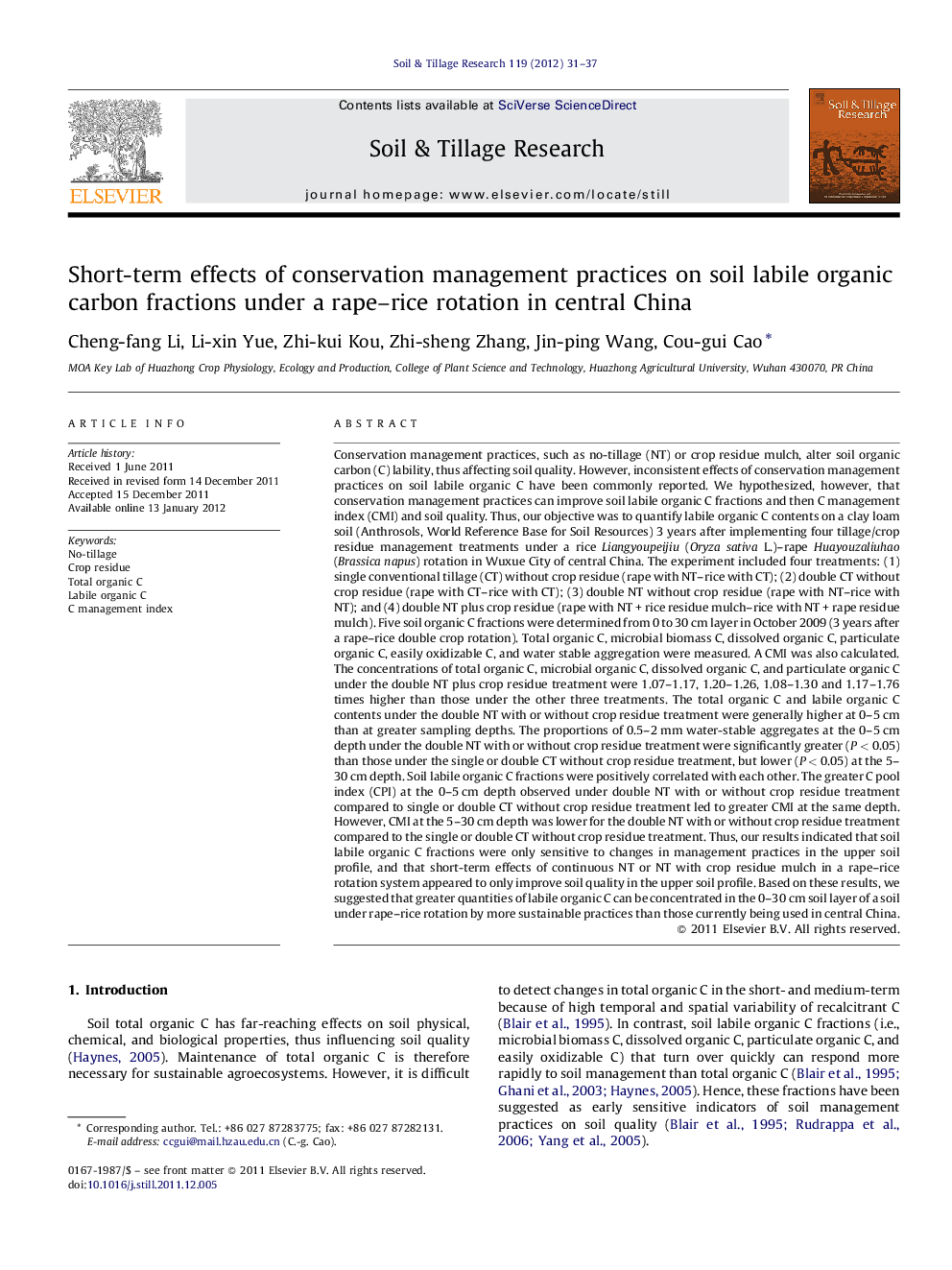| کد مقاله | کد نشریه | سال انتشار | مقاله انگلیسی | نسخه تمام متن |
|---|---|---|---|---|
| 306058 | 513069 | 2012 | 7 صفحه PDF | دانلود رایگان |

Conservation management practices, such as no-tillage (NT) or crop residue mulch, alter soil organic carbon (C) lability, thus affecting soil quality. However, inconsistent effects of conservation management practices on soil labile organic C have been commonly reported. We hypothesized, however, that conservation management practices can improve soil labile organic C fractions and then C management index (CMI) and soil quality. Thus, our objective was to quantify labile organic C contents on a clay loam soil (Anthrosols, World Reference Base for Soil Resources) 3 years after implementing four tillage/crop residue management treatments under a rice Liangyoupeijiu (Oryza sativa L.)–rape Huayouzaliuhao (Brassica napus) rotation in Wuxue City of central China. The experiment included four treatments: (1) single conventional tillage (CT) without crop residue (rape with NT–rice with CT); (2) double CT without crop residue (rape with CT–rice with CT); (3) double NT without crop residue (rape with NT–rice with NT); and (4) double NT plus crop residue (rape with NT + rice residue mulch–rice with NT + rape residue mulch). Five soil organic C fractions were determined from 0 to 30 cm layer in October 2009 (3 years after a rape–rice double crop rotation). Total organic C, microbial biomass C, dissolved organic C, particulate organic C, easily oxidizable C, and water stable aggregation were measured. A CMI was also calculated. The concentrations of total organic C, microbial organic C, dissolved organic C, and particulate organic C under the double NT plus crop residue treatment were 1.07–1.17, 1.20–1.26, 1.08–1.30 and 1.17–1.76 times higher than those under the other three treatments. The total organic C and labile organic C contents under the double NT with or without crop residue treatment were generally higher at 0–5 cm than at greater sampling depths. The proportions of 0.5–2 mm water-stable aggregates at the 0–5 cm depth under the double NT with or without crop residue treatment were significantly greater (P < 0.05) than those under the single or double CT without crop residue treatment, but lower (P < 0.05) at the 5–30 cm depth. Soil labile organic C fractions were positively correlated with each other. The greater C pool index (CPI) at the 0–5 cm depth observed under double NT with or without crop residue treatment compared to single or double CT without crop residue treatment led to greater CMI at the same depth. However, CMI at the 5–30 cm depth was lower for the double NT with or without crop residue treatment compared to the single or double CT without crop residue treatment. Thus, our results indicated that soil labile organic C fractions were only sensitive to changes in management practices in the upper soil profile, and that short-term effects of continuous NT or NT with crop residue mulch in a rape–rice rotation system appeared to only improve soil quality in the upper soil profile. Based on these results, we suggested that greater quantities of labile organic C can be concentrated in the 0–30 cm soil layer of a soil under rape–rice rotation by more sustainable practices than those currently being used in central China.
► Soil labile organic C fractions were sensitive to changes in management practices only in the upper soil profile.
► Compared to the single or double CT without crop residue treatment, the double NT with or without crop residue treatment had greater carbon management index at 0–5 cm depth, but lower at 5–30 cm depth.
► Continuous NT or NT with crop residue mulch in a rape–rice rotation system in short-term appeared to only be effective in improving soil quality in the upper soil profile.
Journal: Soil and Tillage Research - Volume 119, March 2012, Pages 31–37